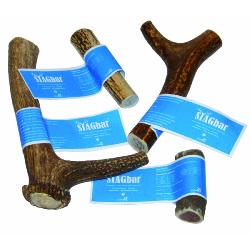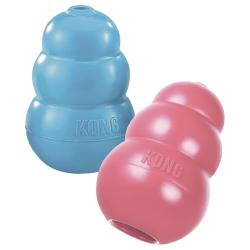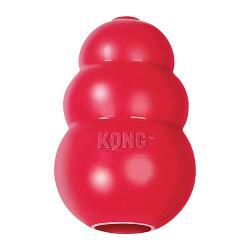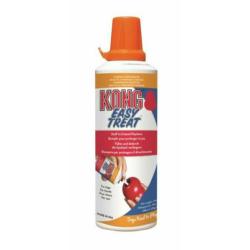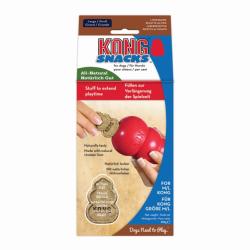 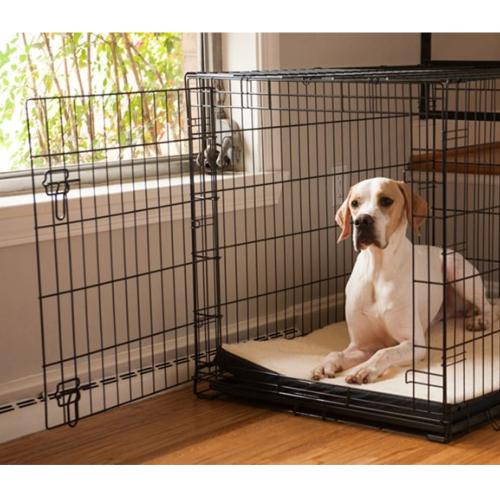 Puppies and adult dogs have a natural liking for enclosed sleeping places. Their canine ancestors would seek out a safe den to sleep and rest, where they were safe from the elements and predators.
The resemblance to cages or prison puts many people off upon first sight. However, if the crate is correctly introduced to the dog, it becomes an extremely helpful training aid and a comforting area for if the dog is stressed. It will also ensure that your dog is comfortable during stays with the vet if needed in the future, and in boarding kennels or with home boarders, who often use crates for the safety of strange dogs in their homes.
A lot of evidence indicates that it is much easier to housebreak a puppy if it is taken out to eliminate before bedtime, placed in a crate overnight, and then taken out again to eliminate first thing in the morning. Use of the kennel crate can also prevent destructive habits from developing since, if the dog is placed in a crate when unsupervised, the puppy never has the opportunity to learn about the pleasures of chewing on your furniture.
The key to successful crate training is selection of a suitably sized crate, ensuring it is comfortable yet safe to leave your pet in, and careful introduction to ensure that the crate is a safe space and never a punishment.  Since our beloved pets come in all shapes and sizes, dog crates are also available with a wide variety of dimensions.
When in a suitably sized crate, your dog will be able to:
Equally, you should not choose a crate which is too large for your dog. If the crate is not cosy, the benefits of feeling safe and secure in their den will no longer apply, which could lead to anxious behaviour in what should be a safe haven. Most puppies will need two crates to allow for suitable sizing as they grow, as buying a crate for them to grow into will often result in bad habits such as toileting in the crate, which should not be encouraged.  Stage 1: Positive Association
Begin with the door open, and sprinkle some treats into the cage, preferably while the dog is not looking. Allow the dog to explore the area and come across these treats, ensuring that there are some treats at the back of the crate so the dog must step right in to enjoy them. If the dog is not discovering the treats, try laying a trail of treats to the cage. Replenish as often as needed and is healthy for the dog, until the dog confidently enters the crate to explore for rewards. Do not be tempted to close the crate door at this stage, even if just for a second to test the dog's reaction. Stay within the vicinity of the crate as much as possible, rewarding the dog regularly and offering meals within the crate. Do not force the dog into the crate at this stage, nor encourage them verbally or otherwise to enter the crate, let it be all on their terms.
The only time you should consider closing the crate is at bed time, and only if you are using the crate alongside your bed or if you are sleeping in the room with the dog. In these situations, where you are sleeping but the dog knows that you are close by, closing the door is less likely to undo all the positive association you have built up with the crate.
You can expect this step to take 24-48 hours, depending on whether the dog has previously had any issues with crating, being enclosed or separation anxiety.
Stage 2: Distracted Door Closure
Once the dog is investigating the crate comfortably, and is happy to eat and lay in the crate with the door open, you can begin to close the door for short periods of time. This is best done as the dog enjoys their meal, a chewy treat or a tasty stuffed toy such as a Kong.
During this stage, never step more than a few feet from the crate. You do not want the dog to associate the door being closed with you leaving them alone. If the dog seems distracted from their activity when the crate door is closed, scatter some super tasty treats into the crate to entice them into enjoying the experience. If the dog panics or cries when the crate door is closed, you must spend more time on step 1.
You can expect this step to take 24-48 hours, depending on whether the dog has previously had any issues with crating, being enclosed or separation anxiety.
Stage 3: Daily Activities
When the dog is readily heading to the crate on their own terms to relax, and appears to be totally chilled out when the door is closed and you are right next to the crate, you can begin to venture further from the crate while the dog is distracted with their toy or chew.
Perform your daily activities around the home, leaving the room where the dog is crated but checking in regularly to ensure that they are distracted or sleeping, and not showing any signs of anxiety.
Once the dog is okay with you moving around the home while they are crated, try sitting in a different room and performing a quiet activity such as reading a book, to gauge whether you may be ready to move onto the next step.
You can expect this step to take 24-48 hours, depending on whether the dog has previously had any issues with crating, being enclosed or separation anxiety.
Stage 4: Leaving the Home
Once your dog is in the crate and settled, perform the routine which you tend to do before leaving the house, gathering your keys, coat, etc. Wander in and out of the room in which the dog is crated, repeating this routine until the dog is no longer interested in what you are doing and has returned to their toy, chew or nap. Repeat this step, leaving the house, closing the door and returning immediately, again until the dog has no interest in your behaviour.
Increase the amount of time spent outside your house, in small increments from 5 seconds to 30 minutes. Try not to increase the length of time your dog is left alone by more than 30 minutes per day.
The first 15 minutes after being left is the time in which your dog is most likely to show separation anxiety, so once you have achieved 15 minutes with no problems it is likely that crate training has been a success. However, it is important to build up the time slowly so as not to undo all of the work you have done to this point.
You can expect to be able to leave your dog alone for 4 hours at a time within 7 days of beginning this step, depending on whether the dog has previously had any issues with crating, being enclosed or separation anxiety.  How long will crate training take for my dog?
Crate training can be completed in less than 1 week for a confident puppy, with better success in those who have come from reputable breeders and rescue foster homes who have spent time introducing the concept of confinement to the dog, without causing frustration. Some dogs are much more prone to separation anxiety, or have confinement issues, and for these dogs it may take upwards of 6 months before the dog is truly happy in the crate.
What do I do before putting my dog in the crate?
Ensure that your dog has had ample opportunity to go to the toilet and has been exercised appropriately for their age and type (mental and physical exercise are both important). Your dog should be ready to rest when they are put into the crate, and helping them to settle with a stuffed Kong toy or suitable chew is ideal.
How long can I crate my dog for?
The length of time for which your dog will be content in their crate will vary from dog to dog, they are all individuals. For a dog which is past their early puppy stage and has been correctly crate trained, up to 4 hours at a time will usually be okay. Your dog should never be left in the crate for longer than they can hold their bladder. Crating all day while you are at work is not ideal, so you should arrange for a friend or family member to attend to your dog through the day, allowing them the opportunity to stretch their legs in the garden and to provide fresh water.
My dog is making noise in the crate - are they distressed or frustrated?
If the whining or barking begins when the dog is in the crate and you are not in the room, you should assume that the noise is due to separation anxiety, and return to a previous training step until this is resolved.
If the dog is also making noise while you are in the room, next to the crate, you can assume that the noise is due to frustration, which can be ignored provided that the dog has distractions available inside the crate.
Do I have to use a crate?
Of course not! Many dog owners raise dogs without the use of a crate, and have no more issues than those who do crate their dogs. However, correct use of a crate is an ideal way to ensure your dog's safety when not being directly supervised, and the vast majority of crate trained dogs will choose to lay in their crate when they need a break from all of the activity in the home.
How long do I need to use a crate for?
Some owners allow their dogs to use their crates throughout their lives, others prefer to remove the crate once the dog can safely be left to roam when the owner is out of the home, usually at around 2 years of age. If you do decide to remove your dog's crate, do it slowly as removal of the den can cause upset. Begin to leave the crate door open so the dog can venture out as they like, while you are not supervising. After a couple of weeks of having the crate door open, remove the crate but leaving the dog's bedding in the area which was previously occupied by the crate. If this does not cause any anxiety, you can move the dog's bedding to a new area if required.
Will crate training help with toilet training?
Very often, crate training is the key to the toilet training of a difficult or confused dog. If the crate is correctly sized, your dog will not want to toilet in the crate as they will instinctually see it as a den area, to which they would not wish to soil or attract other animals towards with the smell of excrement. When crate training a dog who is not yet house trained, it is important to take the dog from the crate to their toileting area at very regular intervals, so as not to force them to use the crate to toilet.
Some dogs will struggle with this, particularly those raised in puppy farm environments which are unfortunately extremely common in Ireland, as they have grown up using their one small area to toilet, eat and sleep. However, these dogs are likely to struggle with toilet training regardless of the method used, so crate training will still usually lead to good results for these disadvantaged dogs.
If you wish to use puppy training pads in your dog's crate, you should select a crate at least twice the size of that which would normally be required for your dog's breed. This is not recommended for most situations as it can lead to confusion and make both toilet and crate training more difficult in the future. |








